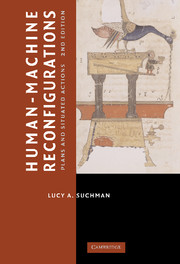Book contents
- Frontmatter
- Contents
- Acknowledgments
- Preface to the 2nd Edition
- Introduction
- 1 Readings and Responses
- 2 Preface to the 1st Edition
- 3 Introduction to the 1st Edition
- 4 Interactive Artifacts
- 5 Plans
- 6 Situated Actions
- 7 Communicative Resources
- 8 Case and Methods
- 9 Human–Machine Communication
- 10 Conclusion to the 1st Edition
- 11 Plans, Scripts, and Other Ordering Devices
- 12 Agencies at the Interface
- 13 Figuring the Human in AI and Robotics
- 14 Demystifications and Reenchantments of the Humanlike Machine
- 15 Reconfigurations
- References
- Index
9 - Human–Machine Communication
Published online by Cambridge University Press: 05 June 2012
- Frontmatter
- Contents
- Acknowledgments
- Preface to the 2nd Edition
- Introduction
- 1 Readings and Responses
- 2 Preface to the 1st Edition
- 3 Introduction to the 1st Edition
- 4 Interactive Artifacts
- 5 Plans
- 6 Situated Actions
- 7 Communicative Resources
- 8 Case and Methods
- 9 Human–Machine Communication
- 10 Conclusion to the 1st Edition
- 11 Plans, Scripts, and Other Ordering Devices
- 12 Agencies at the Interface
- 13 Figuring the Human in AI and Robotics
- 14 Demystifications and Reenchantments of the Humanlike Machine
- 15 Reconfigurations
- References
- Index
Summary
Interaction is always a tentative process, a process of continuously testing the conception one has of … the other.
(Turner 1962: original emphasis)In Chapter 6 I outlined the view that the significance of actions and their intelligibility resides neither in what is strictly observable about behavior, nor in a prior mental state of the actor, but in a contingently constructed relationship among observable behavior, embedding circumstances, and intent. Rather than enumerating an a priori system of normative rules for meaningful behavior, Chapter 7 described resources for constructing shared understanding, collaboratively and in situ. Face-to-face interaction was presented as the most fundamental and highly developed system for accomplishing mutual intelligibility. exploiting a range of linguistic, demonstrative, and inferential resources.
Given this view of the basis for action's intelligibility, the situation of action can be defined as the full range of resources that the actor has available to convey the significance of his or her own actions and to interpret the actions of others. Taking that preliminary definition of the situation as a point of departure, my interest in this chapter is to consider “communication” between a person and a machine in terms of the nature of their respective situations. For purposes of the analysis, and without ascribing intent in any way, I will assume that the machine is behaving on the basis of resources provided by “its” situation, the user in accord with the resources of hers.
- Type
- Chapter
- Information
- Human-Machine ReconfigurationsPlans and Situated Actions, pp. 125 - 175Publisher: Cambridge University PressPrint publication year: 2006
- 1
- Cited by

